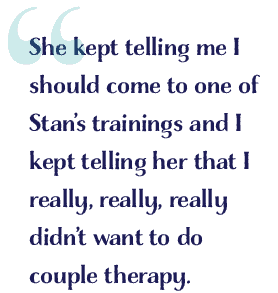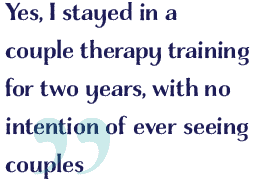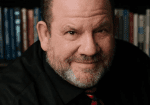True confessions: I never really wanted to be a couple therapist. I tell people that I was a late bloomer when it comes to couple therapy. It’s more accurate to say I was dragged, kicking and screaming, into the world of couple therapy by my friend, Krista.
I always found the idea of couple therapy quite  appealing. Ride in on a white horse, save a marriage… what’s not to like about that? Imagine, helping two people find each other again, re-kindling lost love, yada, yada, yada. Pretty powerful stuff. The reality of couple therapy, on the other hand, scared the tuna salad out of me. What do you do when they start yelling at each other? What if they really don’t like each other? What if, God forbid, they really don’t like me? My conflict avoidant side wanted to avoid all of those possibilities. I like people to like me. I like people to like each other. I really like it when we can all just get along. Since that doesn’t always happen in couple therapy I wanted no part of it.
appealing. Ride in on a white horse, save a marriage… what’s not to like about that? Imagine, helping two people find each other again, re-kindling lost love, yada, yada, yada. Pretty powerful stuff. The reality of couple therapy, on the other hand, scared the tuna salad out of me. What do you do when they start yelling at each other? What if they really don’t like each other? What if, God forbid, they really don’t like me? My conflict avoidant side wanted to avoid all of those possibilities. I like people to like me. I like people to like each other. I really like it when we can all just get along. Since that doesn’t always happen in couple therapy I wanted no part of it.
 Then along came Krista, who also never really wanted to be a couple therapist (there, I just outed her). Krista kept coming to the office yammering on about the study group she was doing with Stan Tatkin. She talked about Stan this and Stan that and how much she was learning from him. Krista had decided that Stan’s model of couple therapy might actually work and that maybe doing couple therapy wasn’t so scary after all. She kept telling me I should come to one of Stan’s trainings and I kept telling her that I really, really, really didn’t want to do couple therapy. However, the promise
Then along came Krista, who also never really wanted to be a couple therapist (there, I just outed her). Krista kept coming to the office yammering on about the study group she was doing with Stan Tatkin. She talked about Stan this and Stan that and how much she was learning from him. Krista had decided that Stan’s model of couple therapy might actually work and that maybe doing couple therapy wasn’t so scary after all. She kept telling me I should come to one of Stan’s trainings and I kept telling her that I really, really, really didn’t want to do couple therapy. However, the promise
that my work as an individual therapist would benefit from Stan’s training
convinced me, and I caved.
That was five years ago, and Krista was right. Like super, duper right. To say that my work as an individual therapist is informed by Stan’s model (a Psychobiological Approach to Couple Therapy, or PACT), would be like saying that Freud kind of influenced psychoanalysis.
Like most humans, therapists grow and change over time in our professional development. Sometimes that growth occurs gradually, as we mature or explore new models. Other times the growth is like an evolutionary leap and our work undergoes a dramatic shift. I’ve had the fortune of experiencing several evolutionary leaps in my career. Learning the PACT model has certainly been one of them. When I started using the PACT lens to look at my individual clients’ interpersonal relationships something changed. I gained a deeper understanding of the dynamics and flow between my clients and the others in their lives. I use the principles of PACT and the criteria for a secure functioning relationship, such as working in a two-person system, to help clients understand some of the dynamics of their relationships. These principles apply not only to romantic partnerships, but to all relationships, including parent-child relationships, sibling relationships, and relationships
between co-workers.
It took two years of studying with Stan before I finally decided to start seeing couples. Yes, I stayed in a couple therapy training for two years, with no intention of ever seeing couples, simply because it helped my work as an individual therapist. Crazy, huh? Here’s something even crazier: I love seeing couples. Truly, truly, I love doing couple therapy. Even when they yell at each other. Even when they don’t really like each other. Even when they don’t really like me (well, that one not so much). Who knew? Well, I guess Krista knew. And Stan.





















